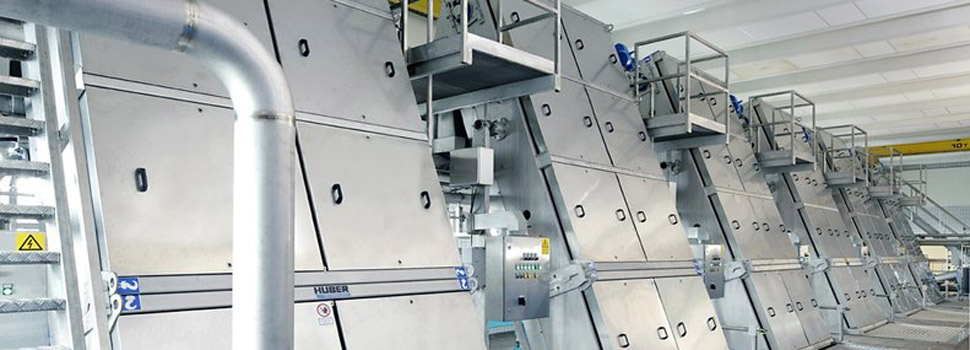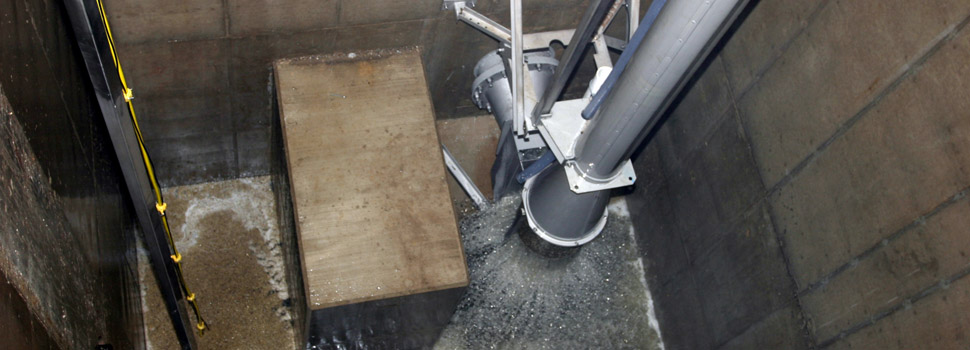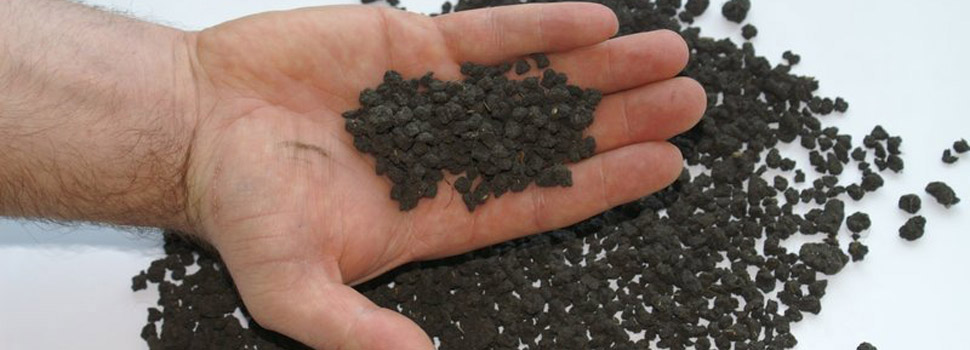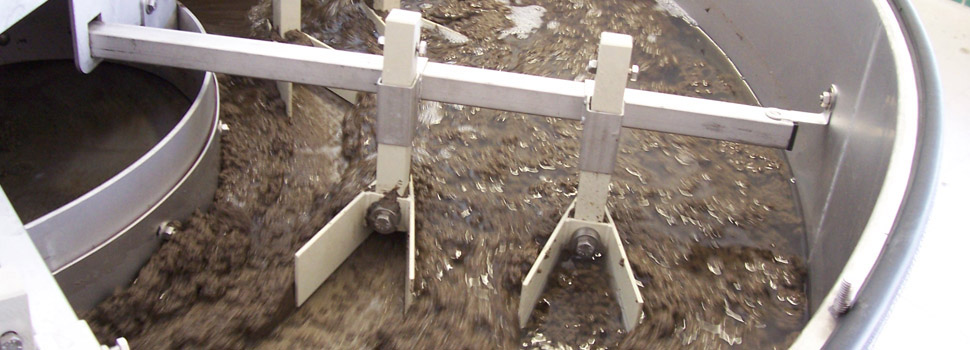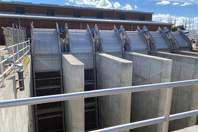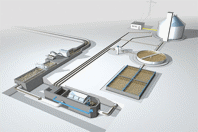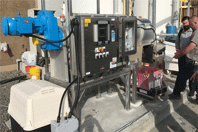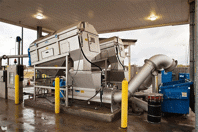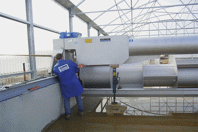HUBER Technology is a leading expert in liquid/solid separation technologies, offering a comprehensive line of screening, grit and sludge handling processes. HUBER serves the municipal and industrial wastewater treatment market with precision fabricated stainless steel equipment that is sought after by those in the municipal and industrial wastewater treatment sector.
Located in Huntersville, NC HUBER Technology, Inc. is a member of the HUBER Group as the wholly owned US subsidiary of Huber SE, based in Bavaria, Germany. HUBER SE, the holder of multiple patents, is the inventor and original manufacturer for the renowned ROTAMAT® and STEP SCREEN® products. HUBER’s experience and expertise is proven in over 25,000 installations worldwide. HUBER’s 175 years of commitment to high quality technology supports its focus on developing innovative solutions to lead the way in resource recovery. More information is available at www.huber-technology.com.
HOT PRODUCTS
-
Drum Screen LIQUID11/27/2018
The HUBER Drum Screen LIQUID is available in different designs and suitable for numerous applications of solids-liquid separation.
-
HUBER Grit Trap GritWolf®8/3/2018
The aerated grit trap is a very important element in mechanical wastewater treatment. Its task is not only to reliably remove the grit from the wastewater flow but also to retain particulate lipophilic substances (grease) to prevent floatable particles from settling or overflowing in downstream treatment systems.
-
Robust Septage Receiving Provides Reliable Operations And Creates Revenue2/21/2017
Huber Technology RoFAS Septage Station is designed to handle environments that would cause standard Septage Stations to fail. Easily processes large debris protecting headworks from unpredictable septage. Center feed allows for rapid offloading. Option for automatic hauler station. Revenue opportunities quickly realizes return-on-investment.
-
HUBER RoSF4 Coanda® Grit Washer Classifier9/1/2016
To produce grit with less than 5 % organic content, we have developed our COANDA Grit Washer RoSF 4. This sophisticated grit washer, combines in a single unit, the conventional functions of grit classifying, conveying and dewatering with a highly effective grit washing process.
-
STEPSCREEN® Fine Bar Screen5/25/2016
Huber Technology, through its subsidiary Huber-Hydropress, is the inventor of the STEPSCREEN® concept. This design was unveiled in the early 1980’s to much acclaim and was readily adopted into the designs of well over 3,000 facilities worldwide since the STEPSCREEN® introduction.
-
Q-Press12/26/2014
The incredible Huber Technology Q-Press for dewatering municipal sludge is providing impressive results in cake solids, polymer consumption, and capture rates. With its slow rotating auger the Q-Press can handle the toughest of sludge with ease.
The Q-Press can quietly run unattended by taking advantage of the fully automatic operation leaving plant personnel to be freed up to attend to other duties. By using only a fraction of the horsepower of other technologies, intermittent wash cycles, and frugal polymer dosing the Q-Press provides low cost of ownership.
-
SRT Solar Active Dryer12/26/2014
The basic principle of the HUBER SRT system is drying of sludge in a solar greenhouse using the available solar radiation. A special sludge turning system performs both spreading and turning of the sludge as well as its transport from one side to the other.
-
SP4 Strainpress – Inline Sludge Screen12/25/2014
The STRAINPRESS® is a horizontal pipe-shaped coarse material separator which consists of inlet and driving zone, screening and press zone and finally a discharge section with a conical pressure regulating device. The coarse material is separated continuously under pressure and periodical cleaning of the screening zone by backwashing is not required.
-
RoS2S Disk Thickener12/23/2014
Huber Technology provides an innovative solution for sludge thickening with its Ro2S Disk Thickener. The RoS2S Disk Thickener’s compact design allows it to fit in even the tightest spaces.
-
Rotamat RPPS Centerfeed Drum Screen12/23/2014
The Rotamat® family of products has been the backbone of Huber Technology’s explosive growth in wastewater equipment worldwide from the very beginning. The heart of the idea has been the ability to create a reliable fine screen that provides screening, conveyance, washing, and compacting all combined into one robust and simple machine. Each of the versions of the Rotamat® screens is a Huber original design.
-
BT Medium Temperature Belt Dryer12/23/2014
Drying of sewage sludge has to meet the conflicting demands between economic efficiency, energy supply, product requirements, disposal safety and utilization options. Drying of sewage sludge minimizes its mass, volume and disposal costs. The produced dry and disinfected biosolids are a valuable product that is well suited for its beneficial use. Different energy sources can be used to supply the heat required for drying. Huber uses a medium temperature design using temperatures up to 293 °F. This is because these temperatures are high enough to ensure quick drying and at the same time provide a cost-effective and eco-friendly utilization of waste heat. Internal recycling of dryer air via a condensator with integrated heat recovery reduces the heat demand of the dryer even more.
-
Rotamat RoK4 Vertical Screen12/23/2014
The ROTAMAT® RoK 4 screen is the ideal solution for pumping stations, whether for new structures or refurbishment. Contrary to conventional screening systems which require manual cleaning, the screen surface of the ROTAMAT® RoK 4 screen is cleaned automatically.
-
The Huber Service Edgesm12/23/2014
As you consider various technologies for your wastewater treatment application, the cost of the equipment as well as proper sizing and implementation are a critical component in the decision making process. However, sometimes how the machine is cared for after installation is not as closely scrutinized as it should be and maybe overlooked. We would like to take a moment to discuss features of what we proudly identify as the Huber Service Edgesm. What we mean by this is; from the moment you make an initial inquiry through the entire useable service life of the equipment, Huber Technology is committed to support you through the entire lifecycle of the equipment. This is backed up by five generations of tradition that demands that we take care of you, our customer. This is something that I observe as severely lacking and much in demand in our industry today.
-
EscaMax Perforated Plate Fine Screen12/22/2014
The EscaMax® is particularly well suited in situations where excellent separation efficiency is required in deep channels with high water levels. The sturdy EscaMax® screen is able to reliably cope with high amounts of gravel and grit. The two-dimensional screening elements prevent especially long fibres from passing through the screen and thus achieve the maximum separation efficiency.
-
RakeMax Multi-Rake Bar Screen12/22/2014
Protecting Your Investment in Technology
When considering effective treatment technology performing at design standards, the headworks of a plant might be the most critical place in a WWTP. What happens there will greatly influence the downstream process.

CONTACT INFORMATION
Huber Technology, Inc.
1009 Airlie Parkway
Denver, NC 28037
UNITED STATES
Phone: 704-990-2055
Fax: 704-949-1020
Contact: Wayne Grooms
FEATURED ARTICLES
-
At WEFTEC 2025, Huber’s Simon Randle discusses how emerging pressures in the industry—from PFAS and microplastics to shifting federal funding—are influencing everything from technology development to workforce priorities.
-
In response to Hurricane Harvey, the Fort Bend, TX Levee District No. 2 embarked on a major upgrade project to increase the flow and capacity of one of its pump stations by 400%. The goal of the project was to protect the area around the district from 100- year floods in the future.
-
Because the WWTP is a heavy energy consumer, the increasing cost of electrical energy helped refocus operations on improving efficiencies and what latent energy could be extracted from the waste stream. In particular, what could be extracted and put to use in the facility itself?
-
Read about the seven ways that the HUBER Sludge Cleaner STRAINPRESS® saves money and time while establishing a safer work environment.
-
When a new wastewater facility is being designed and built, the engineers, contractors, and plant operators look for the most effective and cutting-edge solution available at the time of the install. But while many circumstances can be foreseen and planned for, changing regulations and treatment environments can usurp plant designs, quickly make them obsolete.
-
Wastewater treatment plants provide a viable option to accept and process the collected septage. However, the sheer concentration of the transported sludge can potentially cause plant upsets in smaller WWTP facilities.
-
What is the typical design life of a wastewater treatment plant (WWTP) in North America? This is an important question to consider. Perhaps the better question to consider is: What is important to the operators and beneficiaries of a WWTP facility?
-
The characteristic feature of the HUBER Drum Screen LIQUID is its screen basket which is horizontally installed in the channel or in a tank.
-
In the discussion about limited resources and energy saving in sewage treatment plants innovative sewage treatment methods are increasingly becoming a focal point. In Germany, there are about 1,200 sewage treatment plants which are designed for 10,000 to 50,000 PE, about one third of them have a sludge digester. Thus, there is a potential of about 800 sewage treatment plants that remains for a change from aerobic sludge stabilisation to processes with anaerobic sludge stabilization.
-
City staff were looking for an idea to remedy the logistical issues in the Tarpon Springs Wastewater Treatment Plant located in Pinellas County and known for being a small Greek community on Florida’s Gulf Coast.
-
A Lincoln County Industrial Incentive Grant request was presented Monday night, August 6th, to the board of commissioners by Lincoln Economic Development Association on behalf of HUBER Technology, Inc. Currently located in Mecklenburg County, HUBER has purchased property in Airlie Business Park in Denver to relocate their head-quarter functions initially and as a second phase, begin manufacturing operations in Lincoln County.
-
Scum is not a substance that anyone in a wastewater treatment plants wants to deal with. Scum, the greasy substance that floats to the surface of clarifiers, gets nastier as it accumulates. Some smaller wastewater treatment plants mix their scum back into other processing streams while other larger plants treat their scum separately. The City of Fort Worth takes a unique approach in managing its scum and now turns what was once a liability into an asset.
-
Oostburg’s Black River Falls facility is a lean operation with limitations in space for screening technology and in the staff resources available to manage, maintain and report on the Village’s processes. Even though space was limited, Oostburg knew that putting a headworks screening solution in place would improve their operational efficiency. Oostburg found the perfect solution using the Huber Technology RoK4 confined space vertical screen.
-
Cardston WWTP’s choice of a dewatering system to replace its belt press, Huber Technology Q-Press®, has a striking comparison to the plant’s previous technology in both the footprint and the attention it requires. The Cardston staff also noticed striking improvements in water separation, end-product dryness and offensive odor by-product. Read more about how the Q-Press® helped Cardston become a better neighbor.
-
Reduction of ragging is merely one of the benefits the EscaMAX® Perforated Plate Screen bestows upon its implementer. But this is such a huge factor, that mitigating it brings night-and-day results in other areas such as reducing debris in the grit channel, increasing space for energy-producing biosolids in tanks, and releasing cleaner end products.
-
The video shows how the Huber Technology STRAINPRESS® is designed to effectively remove debris from sludge without breaking line pressure. Sludge is pumped into the Strainpress’ perforated tube and flows through the perforations into a casing while debris is retained within the tube.
-
The Huber Technology Strainpress has helped Napa Sanitation District maximize its investment in the FOG receiving and injection system by improving operations, ensuring the protection of downstream components and enhancing the production of a valuable, revenue generating asset.
-
Fort Worth Village Creek has gone far beyond managing its scum. The plant has implemented an efficient way to continuously skim the scum out of the channel flow and effectively process it through anaerobic co-digestion so that its resulting methane gas is useable. In short, the liability was turned into an asset.
-
Huber Technology Q-Press® replaced a belt filter press at the Robinson WWTP. The retrofit enabled the plant operations staff to maximize technology to make tremendous improvements in their dewatering performance and sludge storage and distribution processes. The technology change resulted in radical improvements to operations and reductions in costs. Read more.
-
Solar dryers are fully automated to feed, move, and discharge biosolids cost-effectively. Even climate changes throughout the year are easily monitored and controlled to produce optimal output. Installation is very flexible with options to add components at a later date. Full automation means employees seldom need to enter the greenhouse and are free to use their time elsewhere.
-
The City of Tooele, UT was looking to update their Bio-Solids program and move away from a limiting Class B product. They needed to produce a more flexible reusable material. The City found the Huber Technology SOLSTICE® to be the perfect solution and was pleased to discover the technology to be simple to maintain as well as provide a cost-effective operation. Find out how the dryer raised the quality of the bio-product to Class A.
-
North Las Vegas has installed some of the largest rotary fine screens operating in the United States. The center feed drum screens are critical to protecting the membrane bioreactor, enabling the plant to maintain extremely low turbidity coming off their plant that is better than most potable water. Read how they are putting the ROTAMAT RPPS to work.
-
The Chiquita WRF plant was looking to improve the performance of their existing gravity thickeners better than the 2.3% DS that they were previously achieving. In their search for a solution they discovered the S-Disc technology from Huber Technology.
-
BCR Environmental utilizes the Huber Technology S-Disc thickener in their sludge neutralization process. Because the system is both simple and reliable they chose to standardize on the S-Disc. The design of the technology enables the operators easy access to monitor their process. Read how BCR is putting the S-Disc to work.
-
With a septage receiving station, you never know what you’re going to get. The Emerald Coast Utility Authority in Pensacola, Florida needed a solution that could handle rocks, debris, grease and other unusual objects the septage might contain. The Huber Technology RoFAS system totally met ECUA’s expectation for reliable operation; handling anything that was brought into the system.
-
The high cost of maintenance and unsatisfactory performance of the aging equipment in the Bonnybrook headworks made it clear that significant changes were in order. The older poorly performing headworks allowed screenings to pass to the downstream process units causing operational and maintenance problems. By installing the Huber RakeMax® and matching WAP washpress, Calgary’s process performance immediately improved.
-
The benefit from the simple automation capability of the Huber Technology Q-Press® began for Contentnea MSD WWTP shortly after installation. Staff was able to focus elsewhere as little attention was required for the system’s operation. The end-product dryness levels vastly improved which radically reduced their haul off costs. Read more.
-
Take a virtual tour of a functioning sludge drying facility. In a comprehensive overview of the Huber BT Belt Sludge Dryer technology you will see how thin sludge is transformed into a dry biosolids product. Observe how the different processes of dewatering, holding, conveyance, drying, and storage work together to provide a complete solution click here.
-
This video shows the receiving, treatment, and classification of WWTP grit, sewer grit and road sweepings creating cleaned and classified inorganics while simultaneously returning organics to process. The Huber Technology RoSF5 Grit Treatment Plant provides an automated solution that addresses the major challenge of different composition of the raw material entering a WWTP which can have a massive impact on downstream grit treatment systems.
-
North Las Vegas’s field facility is an MBR plant that was brand new when Huber’s rotary fine screens were implemented as part of its new water treatment and reclamation process. The facility is “smart,” using a level of technology at which few large plants operate. Huber’s advanced fine screening technology plays a key role in the impressive and innovative technology lineup.
-
City of Tooele needed to reduce sludge volume that would produce reusable material, be simple to maintain, and provide cost effective operation. The Huber Technology SRT Solar Dryer was determined to be a technology fit to achieve Tooele’s goals. The linear feed design of the SRT Solar Dryer provided the ability to feed dewatered sludge to the dryer as it was produced. Read the full case study to learn more about their installation.
-
Previously the crew at Payson WWTP wrestled with clogs that required constant attention and increased system downtimes. With the installation of the new headworks, the comparison was stark because suddenly the flow from the headworks was debris-free.
-
Spanish Fork WWTP utilizes the STEPSCREEN® in two identical headworks systems. The technology upgrade has made a vast difference in plant processing. Prior to the implementation of new technology, only one channel was processed.
-
Huber Technology recently announced Mr. Alvaro Molina Chi joined North American Operations as Private Sales Director-Industrial. Alvaro will be responsible for overseeing all private sector industrial sales.
-
Sooner or later, each wastewater plant has to approach a manufacturer and discuss a purchase. Anyone who has ever tried to buy a piece of expensive, sophisticated wastewater equipment will know there are pitfalls. Some manufacturers offer the best solutions, others don’t. Some manufacturers will go above and beyond to meet a customer’s needs, others won’t. But how do you figure out who has your best interests in mind and who is just out to make a sale.
-
In this 3D animated sequence, the inner workings of the Huber Technology Q-Press® are depicted. The video shows how the sludge enters into the Q-Press® and a slow turning auger moves the sludge through the dewatering process. The animation also shows how the automatic control of screwpress functions.
-
This month we have introduced a series discussing how to remove debris in your sludge. The key technology used to accomplish this is the STRAINPRESS.
-
How do I remove screenings from my sludge? Even when screens are installed at the head of a treatment facility, debris always ends up in the sludge. Plastic parts and fibrous materials can cripple operation of important downstream technologies.
-
In this 3D animated sequence the inner workings of the STRAINPRESS® are depicted. The video shows how the sludge is pumped into the Strainpress’ perforated tube and flows through the perforations into a casing while debris is retained within the tube. An internal screw pushes the retained screenings along the tube’s axis into a conical dewatering and compressing section that is provided with a smaller perforation compared to the screening section.
-
Huber Technology RoFAS Septage Station is designed to handle environments that would cause standard Septage Stations to fail. Easily processes large debris protecting headworks from unpredictable septage. Center feed allows for rapid offloading. Option for automatic hauler station. Revenue opportunities quickly realizes return-on-investment.
-
Huber Technology, Inc. was recently selected by The City of Riverside, California to provide sludge dewatering and MBR protection equipment for a series of upgrades to their facility.
-
A water reclamation facility needed to improve their biosolids handling process in their planned expansion. The solution needed to reduce sludge volume, produce reusable material, be simple to maintain, and provide cost effective operation.
-
The Rotamat® family of products has been the backbone of Huber Technology’s explosive growth in wastewater equipment worldwide from the very beginning.
-
Watch the video for an overview of the RakeMax Multi-Rake Bar Screen.
-
Watch the video for an overview of the HUBER Solar Active Dryer SRT.
-
Watch the video for an animation of the ROTAMAT® Screw Press in action.
-
After two years operation the plant reports that RoS2S Disk Thickener is consistently producing a 5.5% DS average with an ~0.6% DS average feed at a steady flow of 107 gpm (60 gpm activated, 7 gpm trickling, 40 gpm service water) running 24 hours a day.
-
Huber’s center-feed drum screen was recommended as the best technology to prevent wash around that can ruin the membrane bioreactor at a WWTP in Las Vegas.
-
A wastewater plant uses an activated sludge secondary process that utilizes a biological process that introduces microbes as soon as the flow enters the plant.
-
Huber Technology provides an innovative solution for sludge thickening with its Ro 2S Disk Thickener. Watch the video overview to learn more.

